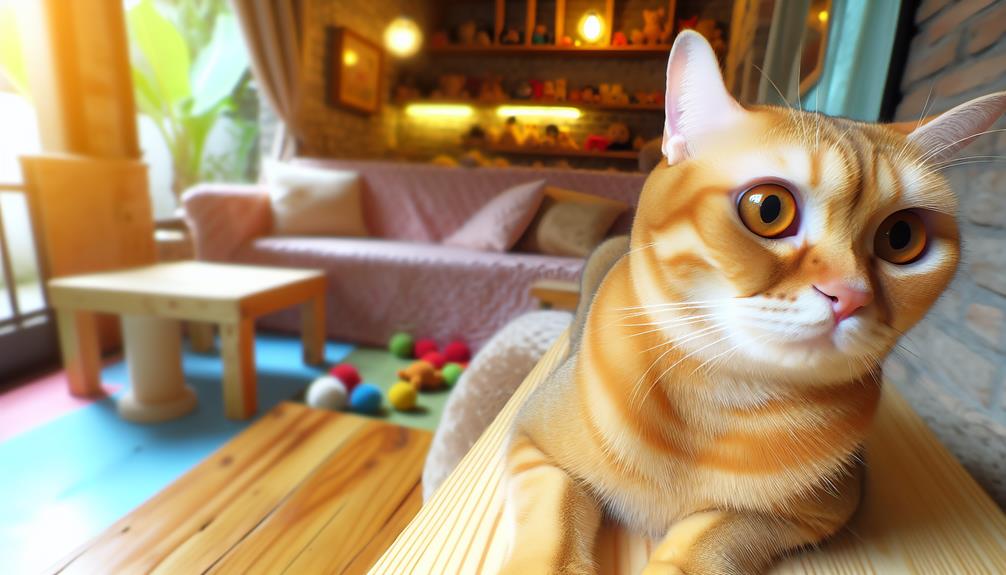Imagine your cat's eyes, like two shimmering emeralds, fixated on you from across the room. It's a familiar scene, yet you might wonder why they're staring so intently. Well, your feline friend might be seeking your attention, showing affection, or simply curious about what you're doing. Sometimes, it's their instinctual behavior kicking in, a remnant from their wild ancestors. But there are also moments when such focused gazes could hint at health concerns. So, what exactly is your cat trying to communicate with those unwavering eyes? Let's explore the possible reasons behind this intriguing behavior.
Seeking Attention
When your cat stares at you, it may be seeking attention, a behavior influenced by its social and communicative instincts. Felines utilize eye contact as a non-verbal communication tool, and their gaze can be a direct indication of their desire to engage with you. Understanding the nuances of this behavior necessitates an examination of their body language and the context of the stare.
In many cases, a cat's fixed gaze signals a desire for playful interactions. If your cat's stare is accompanied by a relaxed posture, ears pointed forward, and a lightly twitching tail, it is typically an invitation for play. This behavior is rooted in their predatory nature, where maintaining eye contact is essential during hunting. By staring at you, the cat is fundamentally inviting you to partake in an activity that mimics hunting, which is a significant part of their behavioral repertoire.
Moreover, the frequency and intensity of the stare can also be indicative of your cat's need for stimulation. Cats are intelligent creatures that require mental and physical engagement. A prolonged, unblinking stare might suggest that your cat is bored and in need of an environmental enrichment or interactive play session. Implementing toys and activities that stimulate their cognitive functions can reduce such attention-seeking behavior.
Additionally, interpreting your cat's body language is critical. Dilated pupils, paired with an intense, unwavering stare, may signal overstimulation or agitation rather than a simple need for attention. It's essential to assess the entire behavioral context to respond appropriately. By recognizing these signs and understanding the motivations behind your cat's stare, you can foster a more enriched and harmonious relationship with your feline companion.
Showing Affection
Staring is not solely a mechanism for seeking attention; it can also be a profound indicator of affection. When your cat gazes at you, it's engaging in a behavior deeply rooted in feline communication. This act can signify that your cat feels a secure attachment towards you, which is a cornerstone of the human-animal bond. From a clinical perspective, cats often exhibit this behavior during bonding moments, reinforcing their emotional connection with their owners.
Scientific studies suggest that mutual gazing between cats and their owners can release oxytocin, a hormone associated with bonding. In this situation, your cat's stare can be interpreted as a sign of trust and affection. They are fundamentally communicating their comfort and attachment to you through sustained eye contact. This behavior should not be misconstrued as purely utilitarian; it underscores a complex emotional landscape.
Moreover, feline communication often includes subtle cues that might be overlooked. For instance, a slow blink, often referred to as a "cat kiss," is another affectionate gesture. When your cat stares and then slowly blinks, it's conveying a message of love and trust. This slow blink can be reciprocated to strengthen your bond, making these interactions bidirectional.
Expressing Curiosity

Cats often stare at their owners as a manifestation of their innate curiosity. This behavior is deeply rooted in feline communication and cat body language. When your cat fixes its gaze on you, it's engaging in an observational activity that helps it gather information about its environment. Cats are naturally inquisitive creatures, and their stare is a tool for understanding their surroundings and the actions of those within it.
From a clinical perspective, this staring behavior can be explained by the cat's sensory processing mechanisms. The feline visual system is highly attuned to detect movement and analyze details, which is essential for both hunting and social interaction. By maintaining eye contact, your cat is effectively processing visual stimuli to make sense of its immediate context.
Evidence-based studies in animal behavior suggest that a cat's stare is a form of non-verbal communication. Unlike humans, cats don't rely heavily on vocalization to convey their thoughts and emotions. Instead, they use nuanced body language. A direct stare can indicate that your cat is curious about your actions or is trying to communicate a need or desire, such as the need for food, play, or attention.
Furthermore, the intensity and context of the stare can provide additional insights. For example, a relaxed, slow blink interspersed with periods of staring may indicate that your cat feels safe and trusts you. Conversely, a more intense, unblinking stare might suggest heightened alertness or even anxiety.
Understanding the nuances of feline communication and cat body language can enhance your relationship with your cat, allowing for more effective and empathetic interactions. Recognizing that your cat's stare is an expression of curiosity can help you respond appropriately, fostering a deeper bond.
Instinctual Behavior
While curiosity drives much of your cat's staring behavior, underlying instinctual behaviors also play an important role. One prominent factor is your cat's inherent hunting instincts. Cats are natural predators, and their visual acuity is optimized for detecting movement. When your cat stares at you, it may be engaging in a predatory behavior pattern, closely observing any minor motion you make, similar to how it would watch a potential prey. This behavior is deeply ingrained and stems from their evolutionary background as hunters.
In addition to hunting instincts, territorial awareness greatly influences your cat's behavior. Cats are highly territorial animals, and their stare can be a method of asserting dominance or establishing control over their environment. When your cat locks its gaze on you, it might be evaluating whether you pose any threat to its territory or attempting to communicate a sense of ownership. This territorial behavior is instinctual and serves to maintain the social hierarchy within the household.
Furthermore, the fixed gaze can be a form of social communication within the species. Cats use eye contact to communicate with each other, and when they extend this behavior to humans, it can signify a variety of messages, ranging from affection to a form of silent negotiation over space and resources.
Understanding these instinctual behaviors adds a layer of insight into why your cat stares at you. It's not just about curiosity; it's a blend of deeply rooted hunting instincts and territorial awareness that drive this enigmatic behavior. Observing these patterns can help you better understand your feline companion's needs and natural inclinations.
Health Concerns

On occasion, a cat's persistent stare can signal underlying health concerns that require attention. Eye health is paramount in feline well-being. Cats might stare due to vision issues, such as cataracts or glaucoma, which can impair their ability to see clearly. These conditions often lead to behavioral changes, including increased dependence on visual cues from their owners. If your cat's stare appears vacant or unfocused, it's essential to seek a veterinary ophthalmologist for a thorough examination.
Another factor to take into account is stress signals. Cats, being highly sensitive creatures, may exhibit prolonged staring as a response to environmental stressors. This behavior could be their way of seeking reassurance or indicating anxiety. Recognizing these stress signals early can help mitigate potential psychological distress and improve your cat's overall quality of life.
Neurological conditions also play a significant role in a cat's staring behavior. Disorders such as epilepsy or brain tumors can cause a fixed gaze, often accompanied by other symptoms like disorientation or uncoordinated movements. If your cat's stare is coupled with these signs, immediate veterinary consultation is advised to rule out serious neurological conditions.
Discomfort signs should not be overlooked. Chronic pain or internal discomfort, such as gastrointestinal issues or arthritis, might cause a cat to fixate its gaze as a coping mechanism. Observing any additional indicators like changes in appetite, grooming habits, or mobility can provide valuable insights into their health status.
Conclusion
Your cat's gaze might be multifaceted. While it could be seeking attention or showing affection through slow blinks, it might also be driven by instinctual behaviors or curiosity. However, juxtapose this with the possibility of underlying health concerns; persistent staring could indicate discomfort requiring veterinary evaluation. Understanding these nuances can enhance your bond and guarantee your feline's well-being. Always observe context and body language to decode the true intent behind that unwavering gaze.
